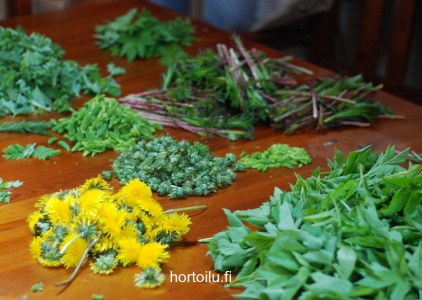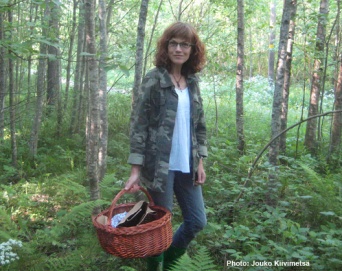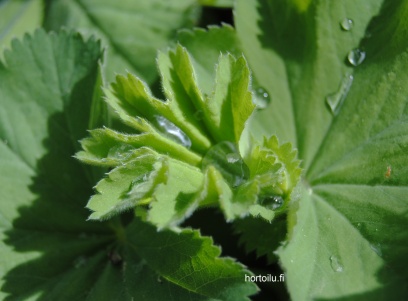Horta hunting, foraging for wild greens and herbs
| Horta hunting, foraging for wild greens and herbs | ||||
|---|---|---|---|---|
| In the national inventory | ||||
|
Practitioners and people who know the tradition well
Foraging and using wild vegetables and herbs, i.e. horta hunting, is a tradition dating back hundreds of years. Similar to picking wild berries and mushrooms, it has remained alive through the ages and is familiar to many Finns.
Reviews from 2000 and 2010 showed that foraging wild plants was the fastest growing forest recreation hobby with a growth of around 50%. Even though the occasional use of wild herbs is also a living tradition elsewhere in the world, Finland currently has the most horta hunters in the world per capita (nearly every forth person over 15 years old). This is no wonder, as the season for growing wild vegetables is particularly long.
Spring and summer days are long, our terrain is easy to travel and our exceptional public rights of access allow us to enjoy the abundance of nature. As the tradition has remained alive so long, Finland can be considered the mecca of horta hunting for the entire world.
In the 1990s, before the current trendiness that has almost led to a mass movement, wild vegetables were mainly seen as useful plants that were gathered occasionally when picking berries or mushrooms. This perspective is promoted in particular by the Arctic Flavours Association, the Martha organisation, 4H clubs, Hyötykasviyhdistys association, educational institutions offering natural resource producer training, Maa- ja elintarviketalouden tutkimuskeskus MTT (research centre for agriculture and food economy) and various projects in the field.
Wild vegetables as the survival food of the forests and delicacies on hikes are in a class of their own, mostly promoted by the Guides and Scouts of Finland, wilderness guides operating as companies and private persons and their training organisations, Metsähallitus and nature centres.
The largest and oldest community promoting foraging for wild plants as a modern way of life is Hortoilijat: the members of the hortoilu.fi website and Hortoilu Facebook community.

Practising of the tradition
Finns like to go outdoors to enjoy nature and spend time at summer cabins. Horta hunting is just as much about being out in nature as it is about foraging for wild greens. Horta hunting opens a door to a much more varied world than just collecting plants. It nourishes the mind, brings people together, opens up our view on nature, offers a new perspective on our food culture and inspires creativity. Often the whole family is inspired to go horta hunting and it can turn into a way of life and a hobby for the family to enjoy together. At the same time, it promotes children’s relationship with nature and their knowledge of nature. There is plenty of research about the beneficial effects of being out in nature; it decreases the symptoms of stress, reduces blood pressure and heartrate, promotes wellbeing of the brain and increases fitness levels. Horta hunting and foraging for natural products increases spending time and exercising in nature.
Wild vegetables are a local food that travel from forest to plate quickly and easily. The local forests, meadows, organic fields and our gardens are treasure chests that forever provide. All Finns can practise this tradition and develop it further in their own, personal style. Foraged greens can be used for many purposes, and thanks to their long shelf-life, they can also delight and treat us during the winter. For the most part, foraging for wild greens is included in the public rights of access, which means that this tradition is truly possible for all.
Wild greens are a renewable natural resource, which also renew those foraging for them with the same certainty as winter gives way to the blooms of spring. The harvest season for wild vegetables is long. It starts as early as April in Southern Finland and, depending on the year, continues till November when the temperatures drop below freezing. Wild vegetables can be collected from a person’s own garden or nearby green areas. Shoots grow new leaves after they have been collected. If one spot is foraged from time to time, it can yield crops for the whole summer. When cooking in an outdoor kitchen at a summer cabin, it is natural to pick ingredients found close by. Children quickly learn which plants are edible and how to use them through example plants are edible quickly through example and learn how to use them.
The most common ways of using wild greens in food are to include them in salads, spreads, side dishes, pies, soups, as flavourings in beverages and in desserts. Smoothies and natural cosmetics are the latest trends. The most enthusiastic horta hunters make liqueur or schnapps, herb vinegar and honey, marinades and ferment the wild greens. In infusions, horta promotes the Finnish herbal tee tradition. Many wild greens are also used as medical plants.
Depending on the plant, all parts of the plant may be usable: the leaves, flowers, stems, root, seeds, sprig growths and buds. Wild vegetables used for cooking can be frozen. Wild greens can also be dried and used as tea during the winter or ground into a green powder to give flavour to foods. Leaves and flowers can also be fermented to give them more flavour.

The background and history of the tradition
The foundation of horta hunting is home cuisine based on local food, a proactive approach to health and an empowering nature-based hobby. As such, horta hunting also fits in well with the needs of urbanised modern people and it is a ground-breaking example of using wild plants as a living folklore.
Before, Finns mainly ate wild vegetables as emergency food when there was nothing else left, which left foraging for wild greens with negative connotations for a long time. During the famine in the 1860s, Lönnrot educated people about how wild plants could help prevent scurvy. Commissioned by the ministry looking after the welfare of people, Toivo Rautavaara told Finns suffering from post-war scarcity about the usefulness of Finnish plants.
The more people moved to cities and the more the living standards grew, the less people used wild plants, or ‘weeds’. People interested in home economics, the Hyötykasviyhdistys association and wilderness enthusiasts still gave courses on how to use wild vegetables. The Arctic Flavours Association highlighted information about using wild greens in addition to berries and mushrooms.
In the late 1960s, Professor Yrjö Mäkinen led a project that created a system with a foraged product inspector and advisor as well as a forager card, and this system also included wild plants. Home economics instructors recommended complementing picking berries and mushrooms with foraging for plants during spring. Wilderness enthusiasts often saw wild plants as seasonings for their packed food and as survival food and source of energy during hikes. Despite these measures, after the so-called yuppie years at the beginning of the 1990s, the use of wild plants diminished and become a marginalised phenomenon, even though picking berries and mushrooms were still popular activities.
The growth of the internet gave birth to a new generation of horta hunters, who wanted to use plants for medical purposes; to alleviate or prevent certain problems. Young people also became excited about wild plants towards the end of 2000s, through the superfood boom. Youth have a powerful blender at home, allowing them to mix together large amount of Finnish wild greens to season the foreign superfoods. When the commercial potential of wild food was realised in Finland, the chefs of fine restaurants also became interested in the movement, starting gourmet cooking with Finnish natural ingredients, based on the example of their foreign colleagues.
The transmission of the tradition

The skills required to recognise, collect, process and use wild vegetables in cooking and conserving them have traditionally been passed on within families, from parents and grandparents to children.
During the modern, digital age, websites have come into the picture, the oldest and best known of which is the hortoilu.fi blog and information page. Hortoilu.fi states that weeds are riches that should not be destroyed or hated, but cherished and eaten. The site also offers information about horta hunting live courses in nature arranged by trained instructors all over Finland and it has produced Villiinny villivihanneksiin (go wild for wild plants) – an online course that teaches the basics of horta hunting. The site has shared information and new tips since the early 2000s and it has achieved a growing number of followers and a huge amount of likes for its horta hunting Facebook page (currently almost 27,000).
Additionally, the Hortoilu.fi site has arranged a national horta hunting recipe competition three times, collecting the recipes of foragers and rewarding interesting food innovations that are simple to make at home. These have been published on the site and also in the leading guide book for horta hunting: Horta Hunter's Handbook (originally Hulluna hortaan), (Mividata Oy, 2013). The horta guides of the Hortoilu.fi community give lectures at libraries, events, fairs and companies about the use of wild greens, teach safe use of wild plants to restaurants and also organise free-of-charge public events. The largest of these in 2017 was the Villiinny villivihanneksiin (go wild for wild plants) event in Träskända, Espoo on 20 May, Finnish Nature Day. The event was also a Restaurant Day, where visitors could taste treats with wild greens for a small fee.
Organisations that have spread this tradition are, in particular, the Martha organisation, 4H clubs, Hyötykasviyhdistys and the Guides and Scouts of Finland. They include foraging information in many of their programmes or organise actual wild herb courses, as do the local community colleges and adult education centres. Training for using wild plants is included in natural resource producer degrees in many vocational institutes and the training for wilderness guides.
Horta hunting has increasingly become a common part of meetings between families and friends, who share information about the plants in their backyard. Companies organise occupational wellbeing events with the theme of horta hunting. Horta hunting can also be the theme of a birthday party, retirement celebration or a hen or stag party. Information about using wild plants is shared at nature and wilderness events. In particular, the websites luontoportti.com and arktisetaromit.fi have published identification data for wild herbs and plant catalogues online.
The future of the tradition
Foraging and using wild greens is now more popular then ever. Horta hunting is no longer only a hobby of horticulturists or health enthusiasts, but instead it has become an attractive recreational activity that anyone can easily start.
A vegetarian diet, healthiness, nature excursions and relaxation, doing things together with the family and creative cooking are all things that promise a bright future for horta hunting.
Interest in foraging started growing thanks to superfoods and local food trend. The superfood boom is still continuing, but local superfoods are now more interesting as replacements for imported products, which is increasing the foraging of Finnish wild plants, especially among young people.
Research has been carried out into the components and active substances of wild greens. Many of them beat their cultivated equivalents in terms of amount of vitamins, minerals and other components with health benefits. Further knowledge will increase the popularity of foraged wild plants. As the research data about the exceptionally large health benefits of the ‘weeds’ in the northern zone in particular increased, many SMEs in the field created new local products based on this information, especially in the Rovaniemi-Kemijärvi regions. With regard to plants, the difficulties with interpreting the degree concerning new foodstuffs have slowed down the development of the utilisation of wild plants for employment in rural areas, but after these initial difficulties have been overcome, the market seems promising. In addition to collecting true wild plants, cultivating wild plants, mostly nettles, rosebay willowherb and dandelions and productising them as dried powders has emerged as a business. For the local collectors of wild plants, it is essential that shops state whether the wild plant is an authentic, foraged natural product or whether it has been cultivated by fertilising it, machine picked and dried at high temperatures, as the quality difference between these two products is very high. Finnish nature interests tourists. Some horta hunting trips combined with culture trips have already been arranged, but this will become more common as more operators emerge in the field. In Lapland, the attractions could be horta hunting in the summer and the aurora borealis in the winter.
Immigrants are a group, some of whom have their own traditions in using wild plants as food and who find it easy to start using wild plants after they learn the plants. Urban residents require edible parks, in addition to plant boxes and sacks, green areas with clean soil and an unpolluted environment. The unemployed are another group who can benefit from wild greens as additional income and nutritional, free extra food.
The communities behind this submission.
Experts
Horta picking instructors Jouko and Raija Kivimetsä, wilderness guides Leena Ilmarinen, Heidi Junkkari and Maija Narinen
Bibliography and links to external sources of information
Online sources and links
[1] Wild vegetables and horta hunting guide and recepies website
Information on The Martha Organization's wild vegetable courses
Plant species and identifying plants
Bibliography
Kivimetsä, Raija 2016: Villiinny villivihanneksiin – Elinvoimaa ja energiaa luonnosta. Kirjapaja.
Kivimetsä, Jouko & Raija Kivimetsä 2013: Hulluna hortaan. Mividata Oy.
Kivinen, Raija 2005: Villiinny villivihanneksiin. Lasten Keskus.
Moisio, Simo, Yrjö Mäkinen, Marja Tuominen & Jukka Vauras 2012: Luonnonyrttiopas. Opetushallitus.
Mäkinen, Yrjö, Paula Hakala, Jukka Vauras & Riitta Vauras 1996: Kauppayrtit. Edita.
